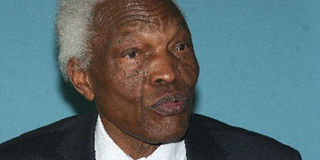TJRC proposes free access to public beaches

Truth Justice and Reconciliation Commission (TJRC) chairperson Bethuel Kiplagat addresses a press conference on May 23, 2013. The TJRC report also proposes that all beach access routes and fish landing beaches, which have been grabbed over the years, be opened to the public. PHOTO | NATION MEDIA GROUP
What you need to know:
- The TJRC was instituted after the 2007/2008 post-election violence to address historical injustices and seek truth and reconciliation.
- It noted that land-related injustices at the Coast were started by Arabs and perpetuated by the British on the coastal strip and in the mainland.
- The report accuses some politicians and administration leaders - some of whom are currently holding office - of being perpetrators of land injustices and recommended that they be prosecuted.
Kenyans will have access to all public beaches at the Coast while illegally acquired titles will be revoked should recommendations by the Truth, Justice and Reconciliation Commission report be implemented.
The TJRC report also proposes that all beach access routes and fish landing beaches, which have been grabbed over the years, be opened to the public.
Cord leader Raila Odinga has been pushing for the tabling in Parliament and implementation of the TJRC report, an issue that is gaining currency in the opposition.
On Saturday, Deputy President William Ruto accused Mr Odinga of misleading Kenyans on the report, saying there was a National Lands Commission (NLC) in place that was dealing with land issues.
With the emotive land issue remaining a sore thumb in Kenya, how to address historical injustices at the Coast is turning once again into a campaign issue.
Coastal leaders have constantly claimed that landlessness is on the rise in the region and that the Jubilee government has failed to solve it through resettlement programmes as recommended by the report.
The TJRC was instituted after the 2007/2008 post-election violence to address historical injustices and seek truth and reconciliation.
In its final report, it noted that land-related injustices at the Coast were started by Arabs and perpetuated by the British on the coastal strip and in the mainland.
“Indigenous Kenyans expected the injustices to be fully addressed soon after Independence but the first independence government failed to fully and genuinely address the problems,” the TJRC report stated.
It recommended that the NLC works with the Ministry of Lands to register people at the Coast and all other areas where the same has not been conducted.
“National Land Commission is now in charge,” said Mr Ruto last week, arguing that all issues raised in the report with be handled by the commission.
Historical land injustices were also said to have led to the emergence of groups such as the Mombasa Republican Council (MRC).
During his recent visit to the Coast, Mr Odinga vowed not to rest until the government implemented the recommendations.
He said the findings will be the solution to historical injustices bedeviling Kenyans and that the opposition will not accept attempts by the Kenyatta administration to gloss over the report.
TJRC says that although land-related injustices have affected virtually every part of Kenya, communities at the Coast — especially the Mijikenda, the Taita and Pokomo — have suffered the most and the longest.
The Bethwel Kiplagat-led commission also recognised that some of the leaders at the Coast had perpetrated land injustices and were, therefore, not fit to participate in efforts to redress land-related problems.
RECOMMENDATIONS
In May last year, NLC chairman Muhammad Swazuri told Parliament’s Committee on Land and Natural Resources that it had been difficult to fix land problems at the Coast due to vested political interests.
TJRC recommends that the Ministry of Lands immediately begins a process of surveying, demarcating and registering all remaining government lands, including those that were formerly owned or managed by local authorities, all protected wildlife areas and river banks, among other public lands.
It also recommended that NLC expedites the process of recovering all irregularly/illegally acquired land by designing measures to encourage individuals and entities to surrender illegally acquired land.
It also recommended that the National Land Commission develops, maintains and regularly updates a computerized inventory of all lands in Kenya, including private land that should be accessible to all Kenyans as required by law.
“The Commission also recommends that the National Land Commission formulates and implement strict guidelines in terms of maximum acreage an individual or company can buy hold in respect of private land,” the TJRC recommended.
Apart from the Coastal region, the commission stated that the expulsion of the Endorois, Ogiek, Sengwer, Wataa, Bajuni, Boni, Talai and other communities from their ancestral lands, and the allocation of forest lands to other communities, had led to the destruction of forests and ethnic conflicts.
“The Commission finds that there is a very close linkage between land injustices and ethnic violence in Kenya…more specifically, land related injustices are prominent factors that precipitate violence between and within ethnic tribes in Kenya,” it stated.
The report accuses some politicians and administration leaders - some of whom are currently holding office - of being perpetrators of land injustices and recommended that they be prosecuted.
Among those mentioned included: Francis Nyenze, whom it said oversaw the illegal excision of 3,000 acres of Hombe forest and irregularly allocated the same to himself and to others while he was the Minister in charge.





